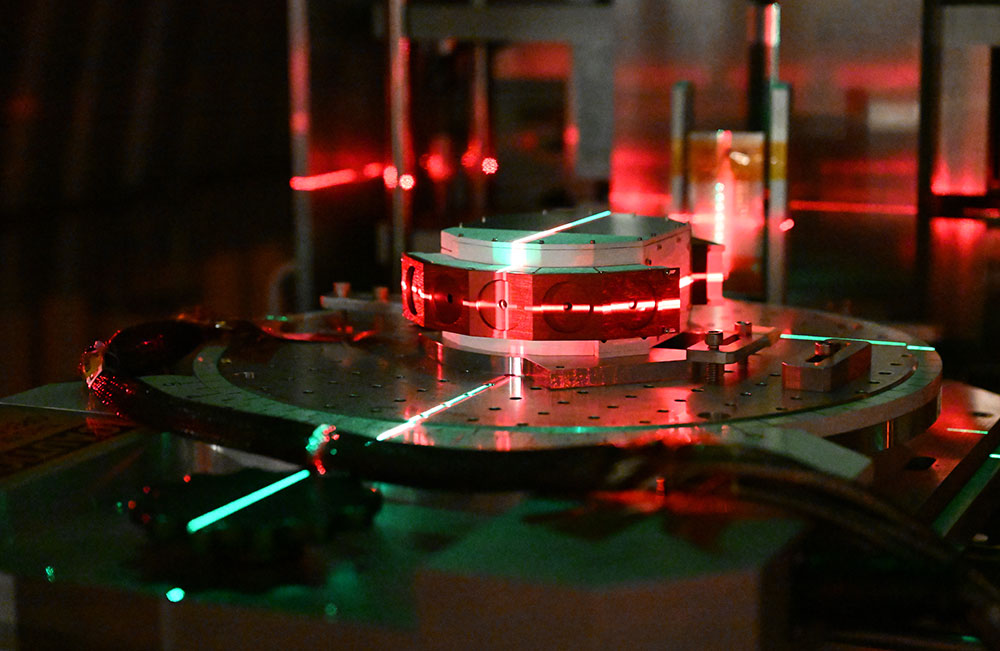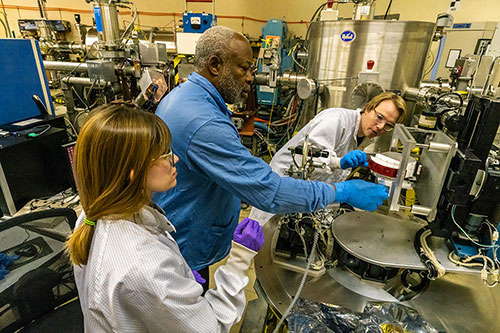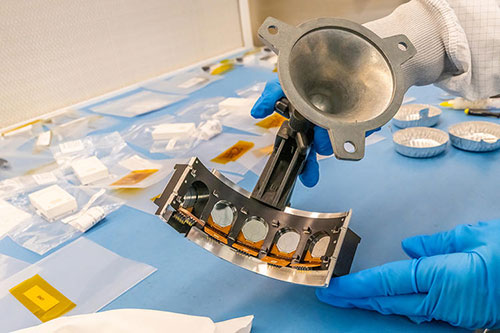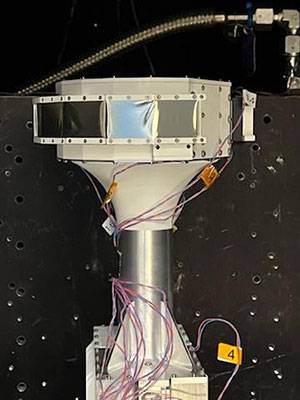New Instrument to Measure High-energy Solar Particles as Part of NASA Mission
June 5, 2024
 enlarge
enlarge
The High-energy Ion Telescope being tested at the NASA Space Radiation Laboratory, which is located at Brookhaven National Laboratory. (Kevin Coughlin/Brookhaven National Laboratory)
Editor’s note: The following news story was originally published by Princeton University. NASA tested the High-energy Ion Telescope at the Tandem Van de Graaff and the NASA Space Radiation Laboratory, two facilities located at the U.S. Department of Energy’s Brookhaven National Laboratory. For more information on Brookhaven’s role in this work, contact Stephanie Kossman (skossman@bnl.gov, 631-344-8671).
Scientists and engineers at NASA Goddard are poised to deliver a new instrument, the High-energy Ion Telescope (HIT), which is a solar energetic particle (SEP) detector. HIT is critical to NASA’s Interstellar Mapping and Acceleration Probe (IMAP) mission to explore our solar neighborhood – decoding the messages in particles from the Sun and beyond our cosmic shield. Since 2018, a team from NASA Goddard in Greenbelt, MD has led the development of HIT, one of the mission’s 10 scientific instruments.
This week, HIT will be shipped from NASA Goddard, for the short ride to Johns Hopkins University Applied Physics Laboratory (JHU/APL) in Laurel, MD. A group of Integration & Test engineers will then begin the process of installing HIT onto the IMAP spacecraft.
 enlarge
enlarge
HIT instrument installed in the vacuum chamber at the Tandem Van de Graaff accelerator facility at Brookhaven National Laboratory in Upton, New York. People in the picture: Mariana Jeunon Barros Ferreira, Bill Reaves, and Grant Mitchell. Image Credit: NASA Goddard/Alessandro Bruno
HIT is the fourth IMAP instrument to arrive at APL. Over the two-year mission, HIT will measure high-energy solar energetic particles expelled from the Sun in the highest energy processes in our heliosphere. Understanding the acceleration and transport of this high-energy radiation will help us better understand our Sun and the local space weather to which these particles play a critical role.
While solar storms produce the beautiful aurora, or “northern lights,” that can be observed when storms of those particles reach the Earth, on the other hand, solar energetic particles are also some of the most hazardous consituents of space weather, posing risks to the health and safety of astronauts, aircraft crew, and danger to space- and ground-based assets and infrastructure.
Eric Christan, HIT instrument lead and Deputy Principal Investigator (DPI) of the IMAP Mission, points out “Solar energetic particles have been studied since the start of the space age, yet we still don’t understand their origin well enough to predict when they will be a danger. HIT, combined with other instruments on IMAP such as CoDICE, will provide an important piece of the puzzle: how SEPs get acceleration from suprathermal particles at lower energy.”
IMAP, which is led by Princeton University, is slated to launch in spring 2025 and will journey roughly 1 million miles to a point in space between Earth and the Sun called Lagrange Point 1.
 enlarge
enlarge
Close up of the HIT sensor head with the L1 and L4 detectors mated to their housings on the collimator apertures. Image Credit: NASA Goddard Cleanroom
During the mission, HIT will measure energetic ions and electrons to help us learn more about the processes that can accelerate these particles to such high energies.
Grant Mitchell, who works as a member of the HIT science team, explained that the instrument is the result of years of work from a team of professionals at NASA Goddard. One of the goals of the IMAP project is also to provide young researchers, like Mitchell, with the opportunity to take on leadership roles. As part of the IMAP Heliophysics Future Leaders group, Mitchell and other early career researchers throughout the IMAP team are being trained in leadership by the senior scientists and engineers on IMAP.
“I am so grateful to have the opportunity to play an integral role in such an exciting mission. The chance to learn from world class scientists and engineers both at NASA Goddard and throughout the IMAP team has been instrumental in preparing me to lead my own missions one day,” said Mitchell.
Building on Heritage
Eric Christian also states that NASA Goddard has a long legacy of measuring energetic particles produced within our solar system and even higher-energy particles accelerated in astrophysical explosions like supernovas. A team from the California Institute of Technology (Caltech) and NASA Goddard previously designed and built a very similar instrument called the Low Energy Telescope (LET). LET is an integral part of NASA’s Solar TErrestrial Relations Observatory (STEREO) Mission, which launched in 2006, enabling stereoscopic imaging of the Sun and solar phenomena, such as coronal mass ejections.
 enlarge
enlarge
Front-view of HIT in vacuum chamber without its red-tag sensor covers after completing a Thermal Vacuum Cycling test. Image Credit: NASA Goddard/Michael Cho
The measurement method used by HIT builds upon techniques that are decades old, but modernizes them with state-of-the-art instrumentation and clever detector design. When charged particles pass through the layers of detectors in HIT, they deposit some of their energy in the detector material until they finally come to rest. By looking at the energy deposit in the different layers through which the particle passed, and comparing it with the energy deposited in the stopping layer, HIT can determine the species (i.e., proton, electron, or different ions) and energy of the incoming particle.
The configuration of the 10 HIT apertures and the spin of the IMAP spacecraft allow HIT to measure particles from all directions and study the spatial distribution of energetic particles incident on the instrument.
HIT also includes 2 special apertures dedicated to the IMAP Active Link for Real-Time (I-ALiRT) data. These apertures measure energetic electrons, which, due to the fact that they are about 2000 times less massive than protons, arrive at the Earth much more quickly and can give us an early warning to upcoming space weather events.
The HIT instrument joins the other particle instruments on IMAP, Co-DICE, SWAPI, and SWE. Together, these instruments measure solar particles over 6 decades in energy including the low-energy solar wind, the medium-energy suprathermal particles, and the high-energy particles measured by HIT.
A Long Voyage Awaits
The HIT instrument would not be possible without its dedicated and diverse group of scientists, engineers, and technicians both at NASA Goddard and Caltech. The HIT team includes many early career scientists and engineers who got the exciting opportunity to take on leadership roles and rose to the challenge. For many, this will be the first time they will have the unique opportunity to work on something going to space.
Jack Letzer, the HIT Project Manager, adds that “the project team is a direct representation of how the IMAP mission team has been put together, insofar as this is a collective that includes senior expertise with many decades of successful flight hardware delivery, combined with extremely talented and skilled scientists and engineers primed for their first technical lead roles, in a mission of far-reaching scientific consequence. It has been a privilege marshaling this cadre of incredibly talented individuals towards delivery of a critical part of the IMAP payload.”
Princeton University professor David J. McComas leads the mission with an international team of 25 partner institutions. The Johns Hopkins Applied Physics Laboratory in Laurel, Maryland builds the spacecraft and operates the mission. IMAP is the fifth mission in NASA’s Solar Terrestrial Probes (STP) Program portfolio. The Explorers and Heliophysics Project Division at NASA Goddard in Greenbelt, Maryland, manages the STP Program for the agency’s Heliophysics Division of NASA’s Science Mission Directorate.
2024-21926 | INT/EXT | Newsroom









